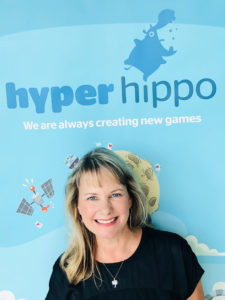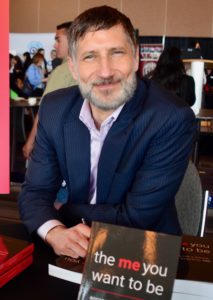The Profits of Play in the Workplace: A (Fun)damental Change
For many of us, it was a mantra we grew up with, “You can’t play until your work is done.” But what if play in the workplace actually enhances work, enabling us to complete it faster and better?
“We’ve been playing for all of our existence,” says Roger Haskett, president of Engagement Unlimited, as well as a professional speaker, actor, and author of the me you want to be.
“Even though we recognize the benefits of play, work has turned its back on play for a long time. I believe in the power of play and that play creates power in people,” says Haskett, who admits to the challenge of actually defining it. “It’s a challenge to define because it’s like art, very individual, but you don’t need to define art to be an artist.
Defining “Play” Less Important Than Doing
“I’ve been speaking about the power of play for five years, but only started defining it in the last year and a half. My definition is that play is in the mind of the player—if it’s fun for you, it’s play,” says Haskett. “My friend runs

Michelle Reid, CPHR
marathons and his idea of fun is a 26-mile practice run. I only run if someone’s chasing me. My idea of fun is talking about play.”
“Play is definitely an individual definition and preference. It’s not necessarily a one-size-fits-all,” according to Michelle Reid, CPHR, HR manager, people and culture at HyperHippo Productions in Kelowna. “Don’t try to force your whole organization to do what you think is fun. You don’t give a plane ticket to someone who’s afraid of flying.”
“I work with a high-intellect, introverted group; often what’s play to them is the opposite of what it is to some others,” says Reid. “It can be something quiet, like reading a book or listening to a podcast. Every industry has a different take on it. In the gaming and entertainment industry, it’s off the charts. It’s a real competitive advantage.”
The Necessity of Play in the Workplace
“Incorporating play into work adds balance, leverages your people’s hard work and shows appreciation for them,” she adds. “Play at work is a competitive advantage. It’s not a nice-to-have, it’s a must-have.”
Reid cites a long list of benefits of play:
- building strong, high-performance teams;
- inspiring employees;
- fostering innovation and creativity;
- increasing productivity, morale, trust and confidence; and
- increasing health and wellness among staff.
“It’s all about engagement and experience. How you treat and value people is part of their total experience. It ties into total rewards in the workplace, which contribute to employee attraction and retention. All the measurements of top places to work — Mercer, Gallup — stress how important engagement is,” says Reid.
“Play can be cultural and it can be a mindset, where the means is more important than the ends,” says Graeme Duffy, a film and TV actor and improvisational comedian who introduces improv to organizations through Vancouver TheatreSports’ Improv for Business. “People need to ask, can we do this in a way that’s joyful or spontaneous and fun?”
“It’s a relatively new attitude,” admits Duffy. “It started in the last decade or so with a lot of start-ups that wanted innovative products and services and extended that to their culture.”
Taking Improv to Work
For the past decade, Duffy has been “taking the improv mindset into teams to help them with collaboration, creativity and communication in the workplace. Organizations ask for teambuilding or education that’s fun. I call it edutainment.”
Two of the basic tenets of improv are “Yes, and…” and supporting each other, Duffy explains. No matter what a fellow improv member says on stage, others respond, “Yes, and…”
“There’s something to be said for the spirit of agreement or acceptance of ideas. People learn to say yes to each other. They’re open to ideas, gain greater creativity through an expanded mindset and improve problem-solving by doing things together, not alone,” says Duffy. “You need to listen for change talk; it’s a sign that people are open to new ways. When people are forecasting what a better day could look like and respond to ideas with ‘Yes, and…’ they build with one another.”
Moving Past “Yes, but…”
“The other response is ‘Yes, but…’ Some people come alive when shooting ideas down. It’s easier to say why things wouldn’t work. When people argue with each other, they expend more energy and are more tired,” explains Duffy. “You have to clarify that ‘Yes, but…’ is for later stages of development, when working out logistics and details.
“At one government agency I visited, one man joked that all their meetings were arguments, but he was casting a light on something he’d like to see change,” Duffy adds.

Graeme Duffy
Putting Play at the Core of Your Culture
“We are seeing a change at work. There’s more play now than there was five years ago, and in 10 years there will be even more,” concurs Haskett. “Playful is an attitude; it can change, ebb and flow, but the attitude is more important than the structure of the play. It’s also contagious.
“We need to become ‘prophets of play,’ speak the language, model it and show its benefits. My mission is to take play out of the gutter and put it in a place of honour,” Haskett says. “We have set up a system that creates weakness, but play has power, connection and a growth mindset. It enables us to see connections we don’t see—if we’ve shut the door on play.”
“Now there is more recognition of the value of culture in the workplace,” Haskett adds. “We talk more about being human at work, asking ‘How as humans are we best served by recognizing our human-ness at work?’ We have issues and powers as humans, and play can enter through those doors.”
So Many Ways to Play
“There’s been a whole shift in the way people are working nowadays, shifting lines in work/life balance,” agrees Reid.
HyperHippo brings all of its team members, with their spouses, to Kelowna from Vancouver, Seattle, Halifax and the Okanagan twice a year for play.
“It brings cross-functional teams together and provides networking and employee experience,” Reid explains. “When you do something different, with a different team, it brings a different mindset. For example, we learned to sail together and identified different strengths in our team.”
“Food can be a big factor in play, too—it brings people together. We’ve brought a chef in to make breakfast. We have gelato days. We have Fun Fridays with not only beer or wine because not everyone drinks alcohol. We did popsicles as an option once, and ice cream sandwiches another time. It’s not about the beer, it’s about connecting and talking about your week,” Reid says. “We also create tie-ins for remote workers. They can’t always participate directly, but we still get them involved, tell them to expense the gelato and post photos of them enjoying it.”
Playing Forward From the Heart
“An increasingly common tactic is for teams to do something together that has a social impact and benefits their community—giving employees company time to go out and do something fun in a cross-functional team that also does something good for your community, like a Day of Caring, working at the food bank, the Boys and Girls Club, even cleaning up a street,” adds Reid.
“It provides a meaningful way people can do something and put their names on it and be proud of it. Play is powerful,” Reid explains. “Having fun and sharing energy builds relationships and strong teams, it inspires innovation and creativity, and it gets you out of your head and widens your comfort zone.”
HyperHippo also gives each employee $3,000 dollars per year from what they call their Brain Fund. “They might use it to go to conferences, take courses, earn designations, buy books. People can customize it to further their own development. Often a group will go together to a conference, and gain more from travelling together and sharing their experience,” says Reid.
The ROIs of Play
“Studies are starting to come out that show how valuable play can be to organizations — how it affects return on investment. It’s valuable to have your team unified by play, and once you begin it, it’s easy to see its power,” says Haskett.
“There are a huge number of advantages to an organization: greater creativity, prevention of burnout, quicker thinking, healing of emotional wounds, less stress and anxiety,” says Haskett. “People who play can organize and retrieve new information better and integrate it deeper into their brains, it encourages teamwork and enables better problem-solving and analysis.”
“It’s a battle in a sense, because there are people who argue that play takes energy away from important things,” Haskett adds. “But we are rising up, putting humans at the centre of work and recognizing that play makes better humans. It seems bizarre not to reach for something that we know has so many benefits. That’s where we need to go. It might take time as people learn and change their views, but organizations that embrace play will create power.”
Selling Play to the C-Suite
Duffy estimates that 60 per cent of his clients have trouble selling his work to their higher-ups. “Until they see it work, they think it’s frivolous, not important. It’s hard to have KPIs and metrics to measure joy. There can be an anxiety on the part of the organizer, especially among government entities where they don’t want to foster a perception that they’re spending public money on frivolous things.
“And yet,” Duffy adds. “The vast majority of people who work in Portland take jobs beneath their education level, because they want to live in Portland. If it feels like a great place to be, it doesn’t feel like work.”
“It’s hard to measure joy or contentment. It may be that not everyone wants to sign up for a marathon or barbecue. But introducing an experience that doesn’t tie directly to what the organization does is a harder sell,” says Duffy. “The biggest thing when trying to convince anyone is to have an advocate in the room. Once people have seen play at work, it’s sold.”
Play as a Best Practice
“Great leaders know how important play is to culture and people,” says Reid. “Play is a best practice. If HR supports play and links it to strategy, it’s easier to get buy-in from leadership. Play should be alive and shared with others, not just an HR goal.”
“HR’s role is really to find best practices and to share them—to model it, to try something new while linking it to organizational strategy and total rewards.” Reid explains, “Measuring reaction can be as simple as a happiness meter, where people give it a thumbs up or thumbs down. HR organizations and associations have a lot of great tools and are sharing best practices a lot out there.”
“We’re seeing a sea change in attitude to various things related to play, including its benefits for mental health,” Haskett adds. “HR is leading it, but it’s not restricted to HR.”
“It’s perfect for HR to be championing play. HR in 2019 is different than it was in 1960, it’s evolved and it now has all sorts of openings for this thinking, recognizing humans as humans, not cogs in the organizational wheel,” says Haskett. “Engagement measures power in an organization. The more engaged your employees and customers are, the more powerful your organization is. HR is at the centre of this. It’s a great place for play to be a topic of conversation, for advocating for budget to support it.”
“HR is really the flag bearer focusing on culture,” explains Duffy. “They’re fulfilling the mandate of the organization, but trying to build culture, too. It’s changed even in the last five years; people even identify themselves differently. They’re bringing back ideas from conferences and integrating them into their culture while keeping the mandate and goals of the company in mind.”
Play Plugs Leadership Into Employees
“Leadership definitely has to play a role in this; that’s where employees’ impression of culture and workplace is formed. Leaders need to model it and temper it, and be plugged into their team.” says Duffy. “It really needs to be

Roger Haskett
modelled from the top to be successful. People will give you a huge return on your investment if you give them what they need.”
“You have to model what you want to see,” Haskett adds, “but we need to educate people about it and elevate it—talk about play more, publish more magazine articles about it, raise it to battle mental health issues. With each action, it gets easier and easier to get to the next step.”
“Two-thirds of people are willing to do something they wouldn’t do before—if you add play to the mix,” Haskett explains. “There’s a video of a metro station that has stairs and an escalator. When they made the stairs into a giant piano, two-thirds of people moved from the escalator to the stairs. Knowing that taking the stairs was healthier wasn’t enough to convince them, but making it fun did.”
Beyond Comfort to Connection
While incorporating play into work might be outside the comfort zone for some organizations, Reid says, “You need to find something, then find someone who’ll champion it and see if it sticks. It might be white water rafting, team sports. or going to the movies. Give people a choice to select what makes a difference to them.”
“Just get started with something. Ask your people what’s important to them, get to know your people. If you link it to your overall purpose and goals, you can really leverage the power of play.” says Reid. “Play is who we are, what we do. We work hard and we play hard.”
People can bring their dogs to work at HyperHippo “and employees have treats in their offices, there are toys in the hall and dog dishes in the kitchen. Employees share photos of their dogs and family vacations,” says Reid. “We’ve blurred the lines between work and home to connect people in different ways.”
“We spend so much time at work that we shouldn’t unplug from our lives while we’re there,” Duffy concurs.
Play in the Workplace Makes Magic Happen
Haskett believes in blurring those lines further and for the better. “We need to discuss play, ask people what we can do that is playful and fun, so we can weave it into our daily and weekly basis to think playfully,” he says. “Play is power. If you pull it into work, it creates power in your staff.”
“I’d actually describe it as a revolution more than as a shift in attitude. We are totally honouring play and its power in our lives. We will not be constrained by old cultural models, but will take on the ones that give us power,” says Haskett. “It will come from the grassroots. Generation Z and Millennials value purpose over profit, which plays right into the power of play.”
“We can create a rich tapestry in an organization if its culture makes it a place where people want to be, where they feel safe, inspired and valued,” Duffy concludes. “If you can find something people can get involved in and care about, if play is in the air, magic can happen more often.”
Nancy Painter is an award-winning communication consultant and writer based in Surrey. She is an active member in both the International Association of Business Communicators and the Professional Writers Association of Canada.
For the latest HR and business articles, check out our main page.










